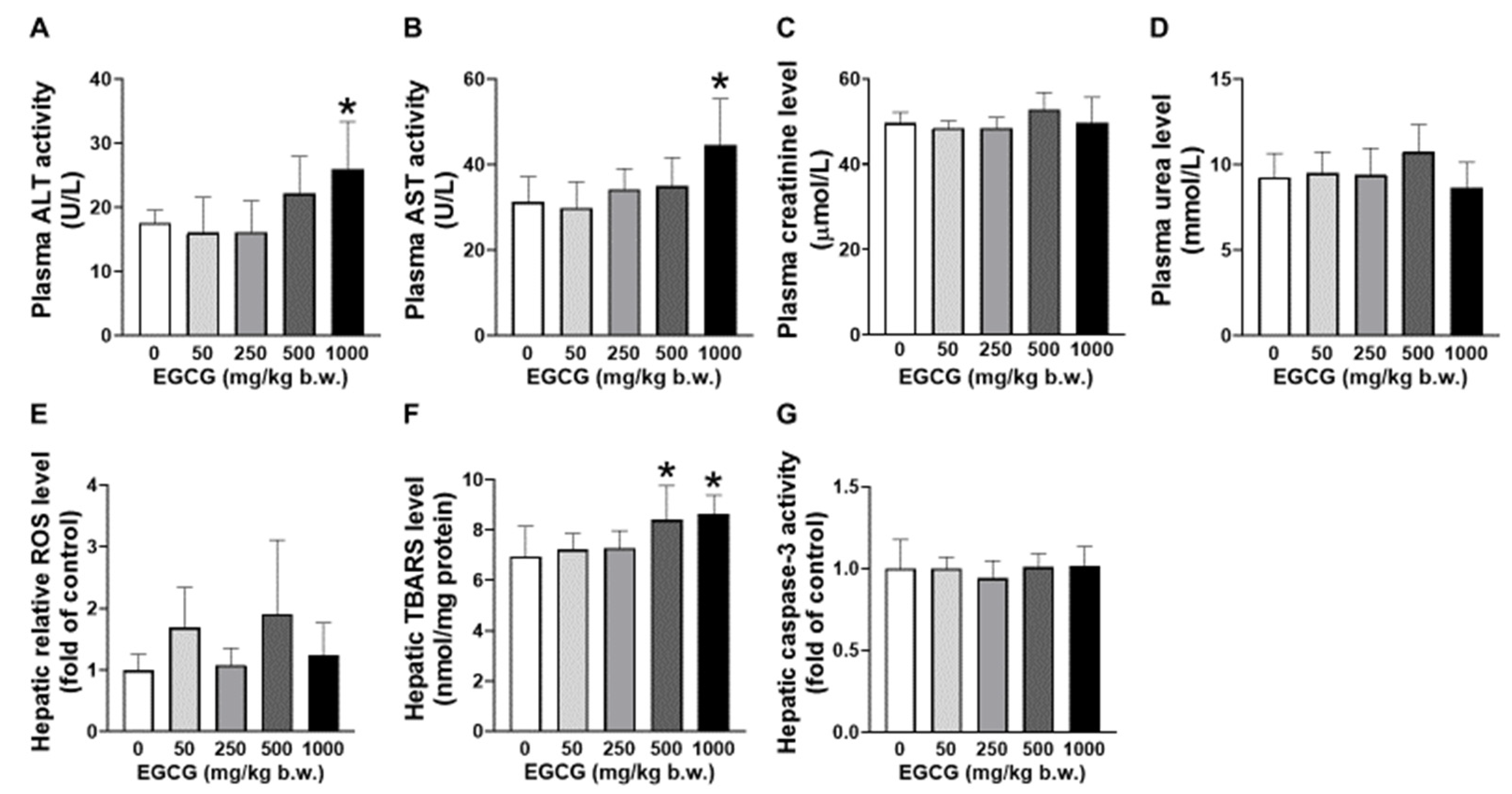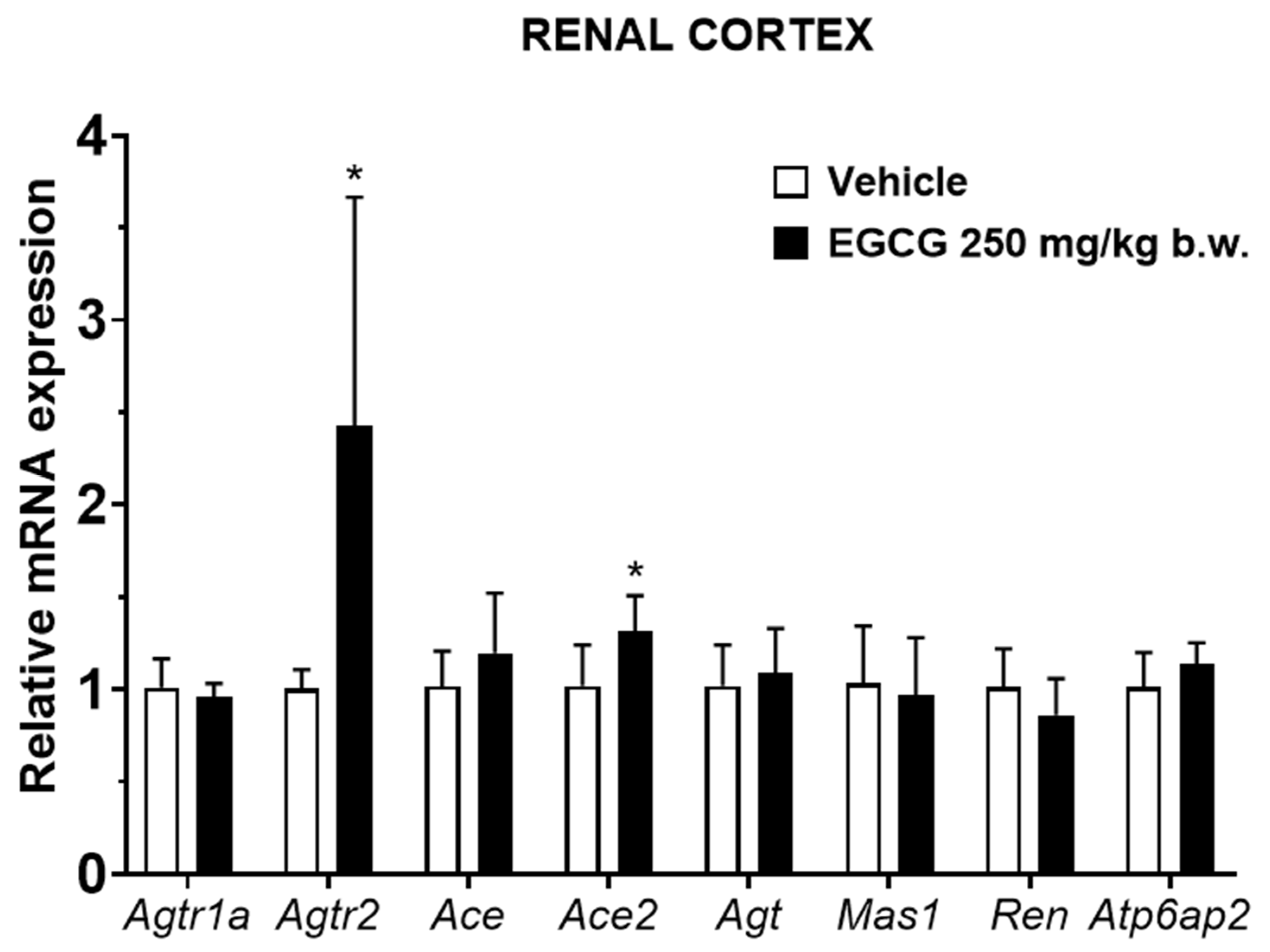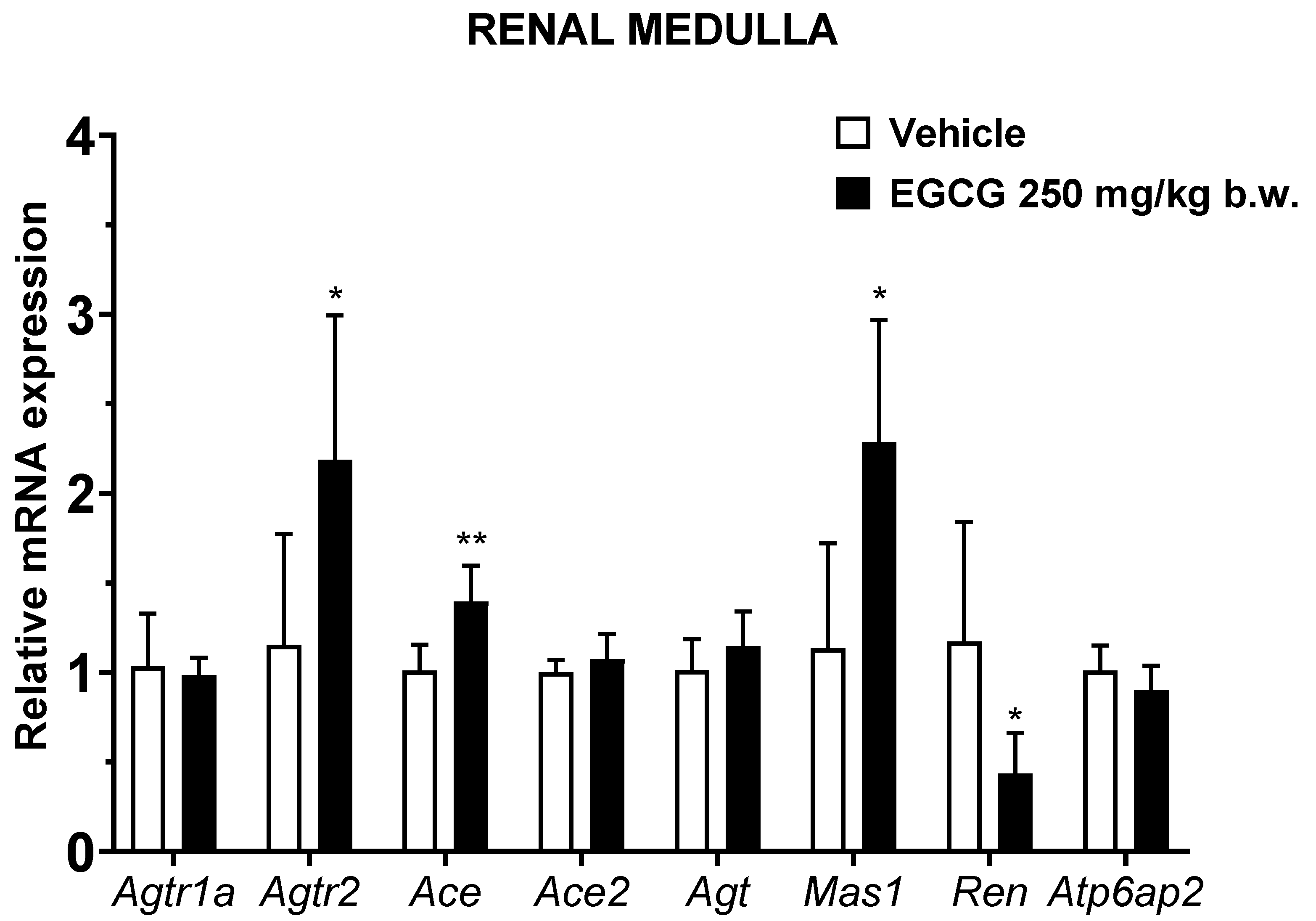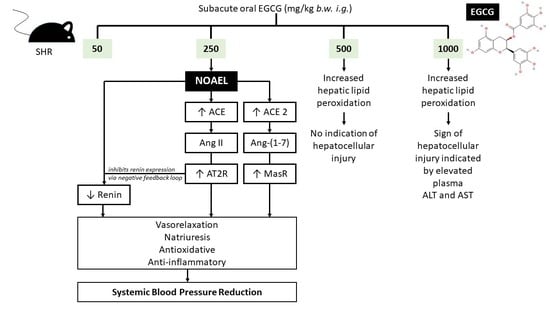Safety and Efficacy of Dietary Epigallocatechin Gallate Supplementation in Attenuating Hypertension via Its Modulatory Activities on the Intrarenal Renin–Angiotensin System in Spontaneously Hypertensive Rats
Abstract
1. Introduction
2. Materials and Methods
2.1. Chemicals
2.2. Experimental Animals
2.3. Phase I: Determination of NOAEL of EGCG
2.3.1. Determination of Biomarkers of Liver and Kidney Injuries
2.3.2. Determination of the Hepatic Oxidative and Apoptosis Status
2.4. Phase II: Determination of Antihypertensive Efficacy of Oral EGCG and Its Nutrigenomics Effects on Expression of RAS-Related Genes in SHR
2.4.1. Blood Pressure Measurement
2.4.2. Measurement of mRNA Expression of RAS-Related Genes
2.5. Statistical Analysis
3. Results
3.1. Cage-Side Observation and Gross Anatomy of the Thoracic and Abdominal Organs and Their Relative Organ Weights
3.2. Effect of EGCG on Plasma and Hepatic Biochemical Parameters
3.3. Effect of EGCG on Blood Pressure Parameters
3.4. Effect of EGCG on the mRNA Expression of Cortical and Medullary RAS-Related Genes
3.5. Statistical Correlation between Blood Pressure Parameters and RAS-Related Genes
4. Discussion
5. Conclusions
Author Contributions
Funding
Institutional Review Board Statement
Data Availability Statement
Conflicts of Interest
References
- Nehme, A.; Zouein, F.A.; Zayeri, Z.D.; Zibara, K. An Update on the Tissue Renin Angiotensin System and Its Role in Physiology and Pathology. J. Cardiovasc. Dev. Dis. 2019, 6, 14. [Google Scholar] [CrossRef] [PubMed]
- Nehme, A.; Cerutti, C.; Dhaouadi, N.; Gustin, M.P.; Courand, P.Y.; Zibara, K.; Bricca, G. Atlas of tissue renin-angiotensin-aldosterone system in human: A transcriptomic meta-analysis. Sci. Rep. 2015, 5, 10035. [Google Scholar] [CrossRef] [PubMed]
- Simko, F.; Hrenak, J.; Adamcova, M.; Paulis, L. Renin-Angiotensin-Aldosterone System: Friend or Foe-The Matter of Balance. Insight on History, Therapeutic Implications and COVID-19 Interactions. Int. J. Mol. Sci. 2021, 22, 3217. [Google Scholar] [CrossRef] [PubMed]
- Kobori, H.; Nangaku, M.; Navar, L.G.; Nishiyama, A. The intrarenal renin-angiotensin system: From physiology to the pathobiology of hypertension and kidney disease. Pharmacol. Rev. 2007, 59, 251–287. [Google Scholar] [CrossRef] [PubMed]
- Szczepanska-Sadowska, E.; Czarzasta, K.; Cudnoch-Jedrzejewska, A. Dysregulation of the Renin-Angiotensin System and the Vasopressinergic System Interactions in Cardiovascular Disorders. Curr. Hypertens. Rep. 2018, 20, 19. [Google Scholar] [CrossRef] [PubMed]
- Marcum, Z.A.; Fried, L.F. Aging and antihypertensive medication-related complications in the chronic kidney disease patient. Curr. Opin. Nephrol. Hypertens. 2011, 20, 449–456. [Google Scholar] [CrossRef]
- Mishima, E.; Haruna, Y.; Arima, H. Renin-angiotensin system inhibitors in hypertensive adults with non-diabetic CKD with or without proteinuria: A systematic review and meta-analysis of randomized trials. Hypertens. Res. 2019, 42, 469–482. [Google Scholar] [CrossRef]
- Dai, S.Y.; Zhang, Y.P.; Peng, W.; Shen, Y.; He, J.J. Central Infusion of Angiotensin II Type 2 Receptor Agonist Compound 21 Attenuates DOCA/NaCl-Induced Hypertension in Female Rats. Oxid. Med. Cell. Longev. 2016, 2016, 3981790. [Google Scholar] [CrossRef]
- Sartorio, C.L.; Pimentel, E.B.; Dos Santos, R.L.; Rouver, W.N.; Mill, J.G. Acute hypotensive effect of diminazene aceturate in spontaneously hypertensive rats: Role of NO and Mas receptor. Clin. Exp. Pharmacol. Physiol. 2020, 47, 1723–1730. [Google Scholar] [CrossRef]
- Liu, G.; Mi, X.N.; Zheng, X.X.; Xu, Y.L.; Lu, J.; Huang, X.H. Effects of tea intake on blood pressure: A meta-analysis of randomised controlled trials. Br. J. Nutr. 2014, 112, 1043–1054. [Google Scholar] [CrossRef]
- Lardner, A.L. Neurobiological effects of the green tea constituent theanine and its potential role in the treatment of psychiatric and neurodegenerative disorders. Nutr. Neurosci. 2014, 17, 145–155. [Google Scholar] [CrossRef] [PubMed]
- Wang, X.; Tian, J.; Jiang, J.; Li, L.; Ying, X.; Tian, H.; Nie, M. Effects of green tea or green tea extract on insulin sensitivity and glycaemic control in populations at risk of type 2 diabetes mellitus: A systematic review and meta-analysis of randomised controlled trials. J. Hum. Nutr. Diet. 2014, 27, 501–512. [Google Scholar] [CrossRef] [PubMed]
- Dou, Q.P.; Landis-Piwowar, K.R.; Chen, D.; Huo, C.; Wan, S.B.; Chan, T.H. Green tea polyphenols as a natural tumour cell proteasome inhibitor. Inflammopharmacology 2008, 16, 208–212. [Google Scholar] [CrossRef] [PubMed]
- Xu, R.; Yang, K.; Ding, J.; Chen, G. Effect of green tea supplementation on blood pressure: A systematic review and meta-analysis of randomized controlled trials. Medicine 2020, 99, e19047. [Google Scholar] [CrossRef] [PubMed]
- Zhang, Q.; Hu, L.; Chen, L.; Li, H.; Wu, J.; Liu, W.; Zhang, M.; Yan, G. (-)-Epigallocatechin-3-gallate, the major green tea catechin, regulates the desensitization of beta1 adrenoceptor via GRK2 in experimental heart failure. Inflammopharmacology 2018, 26, 1081–1091. [Google Scholar] [CrossRef]
- Tan, H.J.; Ling, W.C.; Chua, A.L.; Lee, S.K. Oral epigallocatechin gallate reduces intestinal nadolol absorption via modulation of Oatp1a5 and Oct1 transcriptional levels in spontaneously hypertensive rats. Phytomedicine 2021, 90, 153623. [Google Scholar] [CrossRef]
- Li, F.; Takahashi, Y.; Yamaki, K. Inhibitory effect of catechin-related compounds on renin activity. Biomed. Res. 2013, 34, 167–171. [Google Scholar] [CrossRef]
- Ke, Z.; Su, Z.; Zhang, X.; Cao, Z.; Ding, Y.; Cao, L.; Ding, G.; Wang, Z.; Liu, H.; Xiao, W. Discovery of a potent angiotensin converting enzyme inhibitor via virtual screening. Bioorg. Med. Chem. Lett. 2017, 27, 3688–3692. [Google Scholar] [CrossRef]
- EFSA Panel on Food Additives and Nutrient Sources added to Food (ANS); Younes, M.; Aggett, P.; Aguilar, F.; Crebelli, R.; Dusemund, B.; Filipič, M.; Frutos, M.J.; Galtier, P.; Gott, D.; et al. Scientific opinion on the safety of green tea catechins. EFSA J. 2018, 16, e05239. [Google Scholar]
- Nair, A.B.; Jacob, S. A simple practice guide for dose conversion between animals and human. J. Basic Clin. Pharm. 2016, 7, 27–31. [Google Scholar] [CrossRef]
- Haytowitz, D.B.; Wu, X.; Bhagwat, S. USDA Database for the Flavonoid Content of Selected Foods, Release 3.3; US Department of Agriculture: Beltsville, MD, USA, 2018; Volume 173.
- Aranda, P.S.; LaJoie, D.M.; Jorcyk, C.L. Bleach gel: A simple agarose gel for analyzing RNA quality. Electrophoresis 2012, 33, 366–369. [Google Scholar] [CrossRef] [PubMed]
- Isbrucker, R.A.; Edwards, J.A.; Wolz, E.; Davidovich, A.; Bausch, J. Safety studies on epigallocatechin gallate (EGCG) preparations. Part 2: Dermal, acute and short-term toxicity studies. Food Chem. Toxicol. 2006, 44, 636–650. [Google Scholar] [CrossRef] [PubMed]
- Ramachandran, B.; Jayavelu, S.; Murhekar, K.; Rajkumar, T. Repeated dose studies with pure Epigallocatechin-3-gallate demonstrated dose and route dependant hepatotoxicity with associated dyslipidemia. Toxicol. Rep. 2016, 3, 336–345. [Google Scholar] [CrossRef]
- Rasheed, N.O.; Ahmed, L.A.; Abdallah, D.M.; El-Sayeh, B.M. Nephro-toxic effects of intraperitoneally injected EGCG in diabetic mice: Involvement of oxidative stress, inflammation and apoptosis. Sci. Rep. 2017, 7, 40617. [Google Scholar] [CrossRef] [PubMed]
- Lambert, J.D.; Kennett, M.J.; Sang, S.; Reuhl, K.R.; Ju, J.; Yang, C.S. Hepatotoxicity of high oral dose (-)-epigallocatechin-3-gallate in mice. Food Chem. Toxicol. 2010, 48, 409–416. [Google Scholar] [CrossRef]
- Wang, D.; Wang, Y.; Wan, X.; Yang, C.S.; Zhang, J. Green tea polyphenol (-)-epigallocatechin-3-gallate triggered hepatotoxicity in mice: Responses of major antioxidant enzymes and the Nrf2 rescue pathway. Toxicol. Appl. Pharmacol. 2015, 283, 65–74. [Google Scholar] [CrossRef]
- Ames, M.K.; Atkins, C.E.; Pitt, B. The renin-angiotensin-aldosterone system and its suppression. J. Vet. Intern. Med. 2019, 33, 363–382. [Google Scholar] [CrossRef]
- Siragy, H.M. The angiotensin II type 2 receptor and the kidney. J. Renin Angiotensin Aldosterone Syst. 2010, 11, 33–36. [Google Scholar] [CrossRef]
- Porrello, E.R.; Pfleger, K.D.; Seeber, R.M.; Qian, H.; Oro, C.; Abogadie, F.; Delbridge, L.M.; Thomas, W.G. Heteromerization of angiotensin receptors changes trafficking and arrestin recruitment profiles. Cell Signal. 2011, 23, 1767–1776. [Google Scholar] [CrossRef]
- Ryu, H.H.; Kim, H.L.; Chung, J.H.; Lee, B.R.; Kim, T.H.; Shin, B.C. Renoprotective effects of green tea extract on renin-angiotensin-aldosterone system in chronic cyclosporine-treated rats. Nephrol. Dial. Transplant. 2011, 26, 1188–1193. [Google Scholar] [CrossRef][Green Version]
- Siragy, H.M.; Xue, C.; Abadir, P.; Carey, R.M. Angiotensin subtype-2 receptors inhibit renin biosynthesis and angiotensin II formation. Hypertension 2005, 45, 133–137. [Google Scholar] [CrossRef] [PubMed]
- Potthoff, S.A.; Stamer, S.; Grave, K.; Königshausen, E.; Sivritas, S.H.; Thieme, M.; Mori, Y.; Woznowski, M.; Rump, L.C.; Stegbauer, J. Chronic p38 mitogen-activated protein kinase inhibition improves vascular function and remodeling in angiotensin II-dependent hypertension. J. Renin Angiotensin Aldosterone Syst. 2016, 17, 1470320316653284. [Google Scholar] [CrossRef] [PubMed]




| Observations | Category | Explanation |
|---|---|---|
| General condition | Normal | Awake, active, reacts to stimulation |
| Mild | Burrows in litter, hides, lies still but is startled when handled | |
| Severe | Immobile, little or no voluntary movement. Burrows/hides. Presses head against cage bottom. Vocalizes. Extremely afraid and/or aggressive when handled | |
| Porphyrin staining and/or eye inflammation | Absent | No discoloration, clean and clear eyes |
| Mild | Some porphyrin and/or discharge around eyes and nose | |
| Severe | Obvious porphyrin on ‘face’ and/or on legs and paws. Eye(s) closed, squints and/or discharge around eye(s) | |
| Movements and posture | Normal | Normal coordination without any difficulty in movements |
| Mild | Moderate in-coordination when animal is stimulated; hunched posture | |
| Severe | Marked in-coordination, head held at angle, hunched posture and/or back, does not support itself on all four limbs and/or paralysis | |
| Piloerection | Absent | Fur smooth and well-groomed |
| Mild | Moderate piloerection | |
| Severe | Severe piloerection, sticky and poorly groomed fur | |
| Skin | Normal | Skin covered entirely with fur. No sores or other signs of injury |
| Mild | Small sores or scabs, no infection; scratching (signs of itching) | |
| Severe | Bites or scratches itself or trauma from others. Signs of infection such as redness and/or pus or serious discharge; sticky and poorly groomed fur. Non-healing operation wounds or broken sutures | |
| Appetite/Food and water intake | Normal | Normal appetite, eating and drinking regularly |
| Mild | Reduced appetite, consume less food and water | |
| Severe | No interest in food and appears dehydrated | |
| Defecation | Normal | Firm faecal boli with brown colour |
| Mild | Faeces looser or harder than normal and/or abnormal colour | |
| Severe | Diarrhoea (excessive watery stool)/Constipation (no stool or very hard stool) and/or abnormal colour | |
| Urination | Normal | Normal urine colour (pale yellow to yellowish) without any odour |
| Abnormal | Abnormal urine colour and/or has strong odour | |
| Breathing Difficulties | Absent | Normal respiration, not strained or wheezy |
| Present | Breathes with open mouth, abdominal breathing or panting, crackle and/or gasping noises |
| Gene | Accession Number | Primers | Amplicon Size (bp) | Encoded Protein | |
|---|---|---|---|---|---|
| Gapdh | NM_017008.4 | F: | ATGGGAAGCTGGTCATCAAC | 221 | Glyceraldehyde 3-phosphate dehydrogenase |
| R: | GTGGTTCACACCCATCACAA | ||||
| Agtr1a | NM_030985.4 | F: | CTGCCACATTCCCTGAGTTAAC | 302 | Angiotensin II receptor, type 1a |
| R: | ATCACCACCAAGCTGTTTCC | ||||
| Agtr2 | NM_012494.3 | F: | TAATCTCAACGCAACTGGCACC | 222 | Angiotensin II receptor, type 2 |
| R: | GCCAAAAGGAGTAAGTCAGCCA | ||||
| Ace | NM_012544.1 | F: | GCCCCCTGTACAAGTGTGAT | 347 | Angiotensin-converting enzyme |
| R: | TAGGAAGAGCAGCACCCACT | ||||
| Ace2 | NM_001012006.1 | F: | CAGGAAGCTGAAGACCTGTCT | 251 | Angiotensin-converting enzyme 2 |
| R: | TTCAACTGTTTGTTCTTGTCTG | ||||
| Agt | NM_134432.2 | F: | TTCAGGCCAAGACCTCCC | 309 | Angiotensinogen |
| R: | CCAGCCGGGAGGTGCAGT | ||||
| Mas1 | NM_012757.2 | F: | GGCGGTCATCATCTTCATAGC | 313 | Mas receptor |
| R: | CTTCTTCTTACTGCTGCCCAC | ||||
| Ren | NM_012642.4 | F: | CACTCTTGTTGCTCTGGACCT | 250 | Renin |
| R: | GGGGTACCAATGCCGATCTC | ||||
| Atp6ap2 | NM_001007091.1 | F: | CCGTGGCACCATGGCTGTGCT | 204 | (Pro)renin receptor |
| R: | GCAAGCCCTGGCCAAGACAG | ||||
| Parameters | EGCG (mg/kg b.w.) | ||||
|---|---|---|---|---|---|
| 0 | 50 | 250 | 500 | 1000 | |
| Body weight (g) | |||||
| D0 | 262.9 ± 18.7 | 269.3 ± 17.2 | 273.8 ± 21.1 | 267.2 ± 18.7 | 266.2 ± 18.1 |
| D7 | 275.4 ± 14.0 | 280.2 ± 19.1 | 283.9 ± 16.8 | 272.5 ± 16.6 | 275.1 ± 15.0 |
| D14 | 285.2 ± 11.7 | 290.6 ± 18.7 | 291.8 ± 20.2 | 280.8 ± 18.4 | 282.5 ± 19.1 |
| D21 | 293.6 ± 14.9 | 301.6 ± 21.4 | 302.6 ± 22.4 | 286.3 ± 13.9 | 295.4 ± 19.8 |
| D28 | 305.8 ± 15.4 | 306.7 ± 23.7 | 309.6 ± 22.7 | 289.0 ± 13.3 | 296.4 ± 23.7 |
| Food intake (g/100 g b.w.) | |||||
| D0 | 7.0 ± 1.6 | 7.8 ± 1.3 | 6.1 ± 1.2 | 6.2 ± 1.4 | 6.2 ± 0.8 |
| D7 | 6.8 ± 1.3 | 7.7 ± 0.6 | 7.4 ± 1.2 | 6.8 ± 0.6 | 6.6 ± 0.3 |
| D14 | 6.6 ± 1.2 | 7.0 ± 1.1 | 7.1 ± 0.8 | 6.9 ± 1.2 | 6.5 ± 0.7 |
| D21 | 6.3 ± 0.6 | 6.5 ± 0.4 | 6.1 ± 0.5 | 6.4 ± 0.8 | 6.7 ± 0.2 |
| D28 | 6.3 ± 1.3 | 6.4 ± 1.3 | 6.4 ± 1.1 | 6.2 ± 1.1 | 5.3 ± 0.6 |
| Water intake (g/100 g b.w.) | |||||
| D0 | 8.6 ± 0.5 | 7.9 ± 1.9 | 8.8 ± 0.3 | 7.0 ± 0.1 | 9.8 ± 0.8 |
| D7 | 8.5 ± 0.5 | 9.6 ± 0.2 | 9.4 ± 0.4 | 8.7 ± 0.2 | 8.5 ± 0.7 |
| D14 | 8.6 ± 0.1 | 9.3 ± 0.9 | 9.5 ± 0.6 | 8.8 ± 0.1 | 9.2 ± 0.4 |
| D21 | 8.3 ± 0.1 | 8.8 ± 0.4 | 9.1 ± 1.1 | 8.8 ± 0.7 | 9.5 ± 0.8 |
| D28 | 8.0 ± 0.4 | 9.2 ± 1.3 | 9.6 ± 1.5 | 8.4 ± 1.1 | 7.8 ± 0.6 |
| Observations | EGCG (mg/kg b.w.) | ||||
|---|---|---|---|---|---|
| 0 | 50 | 250 | 500 | 1000 | |
| General condition | Normal | Normal | Normal | Normal | Normal |
| Porphyrin staining and/ or eye inflammation | Absent | Absent | Absent | Absent | Absent |
| Movements and posture | Normal | Normal | Normal | Normal | Normal |
| Piloerection | Absent | Absent | Absent | Absent | Absent |
| Skin | Normal | Normal | Normal | Normal | Normal |
| Appetite/Food and water intake | Normal | Normal | Normal | Normal | Normal |
| Defecation | Normal | Normal | Normal | Normal | Normal |
| Urination | Normal | Normal | Normal | Normal | Normal |
| Breathing Difficulties | Absent | Absent | Absent | Absent | Absent |
| Organ Index (g/100 g b.w.) | EGCG (mg/kg b.w.) | ||||
|---|---|---|---|---|---|
| 0 | 50 | 250 | 500 | 1000 | |
| Heart | 0.4131 ± 0.0182 | 0.4147 ± 0.0260 | 0.4491 ± 0.0652 | 0.4429 ± 0.0267 | 0.4308 ± 0.0146 |
| Lungs | 0.4571 ± 0.0415 | 0.4856 ± 0.0371 | 0.4597 ± 0.0416 | 0.4969 ± 0.0441 | 0.5200 ± 0.0507 |
| Liver | 3.3948 ± 0.3451 | 3.5631 ± 0.1813 | 3.5441 ± 0.1658 | 3.5057 ± 0.2557 | 3.6100 ± 0.0819 |
| Stomach | 0.1891 ± 0.0096 | 0.1786 ± 0.0072 | 0.1958 ± 0.0116 | 0.2047 ± 0.0174 | 0.2024 ± 0.0141 |
| Spleen | 0.5151 ± 0.0964 | 0.4939 ± 0.0620 | 0.4415 ± 0.0316 | 0.4851 ± 0.0691 | 0.5047 ± 0.0790 |
| Small intestine | 1.7391 ± 0.3923 | 1.6474 ± 0.2582 | 1.3964 ± 0.2225 | 1.8305 ± 0.1406 | 1.6194 ± 0.1526 |
| Large intestine | 0.9406 ± 0.1173 | 0.8760 ± 0.0602 | 0.9205 ± 0.1570 | 0.9941 ± 0.1346 | 0.9963 ± 0.1378 |
| Kidneys | 0.7764 ± 0.0156 | 0.8076 ± 0.0416 | 0.7827 ± 0.0368 | 0.7902 ± 0.0319 | 0.8149 ± 0.0187 |
| RAS-Related Genes | SBP | DBP | MBP | |||
|---|---|---|---|---|---|---|
| r | p | r | p | r | p | |
| Renal Cortex | ||||||
| Agtr2 | −0.497 | 0.100 | −0.323 | 0.297 | −0.400 | 0.198 |
| Ace2 | −0.283 | 0.373 | 0.084 | 0.794 | −0.024 | 0.942 |
| Renal Medulla | ||||||
| Agtr2 | −0.586 * | 0.045 | −0.545 | 0.067 | −0.563 | 0.057 |
| Ace | −0.585 * | 0.046 | −0.429 | 0.164 | −0.494 | 0.102 |
| Mas1 | −0.506 | 0.093 | −0.536 | 0.072 | −0.521 | 0.082 |
| Ren | 0.584 * | 0.046 | 0.349 | 0.267 | 0.441 | 0.151 |
Publisher’s Note: MDPI stays neutral with regard to jurisdictional claims in published maps and institutional affiliations. |
© 2022 by the authors. Licensee MDPI, Basel, Switzerland. This article is an open access article distributed under the terms and conditions of the Creative Commons Attribution (CC BY) license (https://creativecommons.org/licenses/by/4.0/).
Share and Cite
Parn, K.W.; Ling, W.C.; Chin, J.H.; Lee, S.-K. Safety and Efficacy of Dietary Epigallocatechin Gallate Supplementation in Attenuating Hypertension via Its Modulatory Activities on the Intrarenal Renin–Angiotensin System in Spontaneously Hypertensive Rats. Nutrients 2022, 14, 4605. https://doi.org/10.3390/nu14214605
Parn KW, Ling WC, Chin JH, Lee S-K. Safety and Efficacy of Dietary Epigallocatechin Gallate Supplementation in Attenuating Hypertension via Its Modulatory Activities on the Intrarenal Renin–Angiotensin System in Spontaneously Hypertensive Rats. Nutrients. 2022; 14(21):4605. https://doi.org/10.3390/nu14214605
Chicago/Turabian StyleParn, Kim Wai, Wei Chih Ling, Jin Han Chin, and Siew-Keah Lee. 2022. "Safety and Efficacy of Dietary Epigallocatechin Gallate Supplementation in Attenuating Hypertension via Its Modulatory Activities on the Intrarenal Renin–Angiotensin System in Spontaneously Hypertensive Rats" Nutrients 14, no. 21: 4605. https://doi.org/10.3390/nu14214605
APA StyleParn, K. W., Ling, W. C., Chin, J. H., & Lee, S.-K. (2022). Safety and Efficacy of Dietary Epigallocatechin Gallate Supplementation in Attenuating Hypertension via Its Modulatory Activities on the Intrarenal Renin–Angiotensin System in Spontaneously Hypertensive Rats. Nutrients, 14(21), 4605. https://doi.org/10.3390/nu14214605







